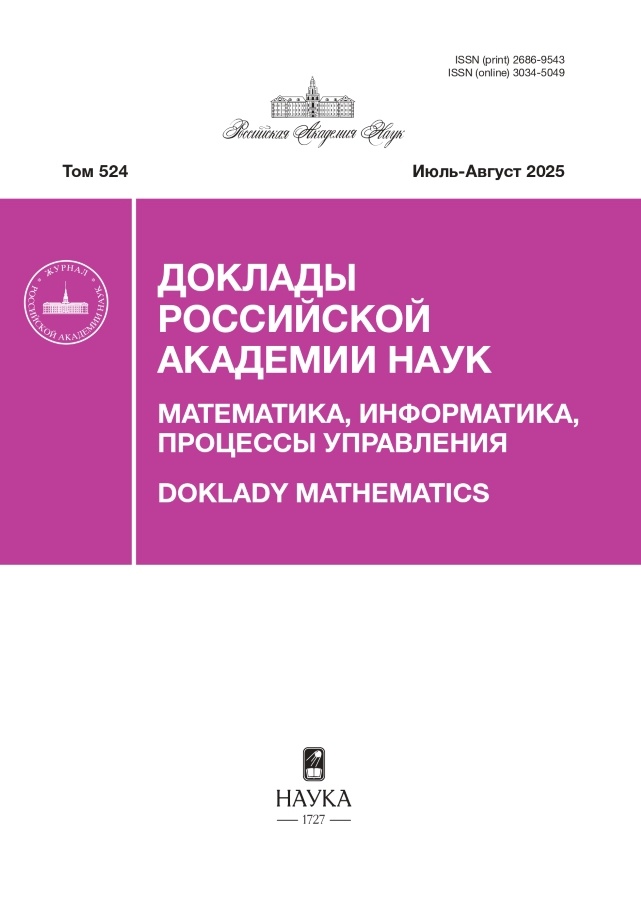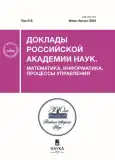Численно-аналитическое решение уравнений Брента
- Авторы: Капорин И.Е.1
-
Учреждения:
- Федеральный исследовательский центр “Информатика и управление” Российской академии наук
- Выпуск: Том 518 (2024)
- Страницы: 29-34
- Раздел: МАТЕМАТИКА
- URL: https://gynecology.orscience.ru/2686-9543/article/view/647987
- DOI: https://doi.org/10.31857/S2686954324040056
- EDN: https://elibrary.ru/YZJHHB
- ID: 647987
Цитировать
Полный текст
Аннотация
Предлагается параметризация канонических разложений тензоров матричного произведения с многократно меньшим (по сравнению со стандартными уравнениями Брента) числом переменных. Последние определяются численно с использованием итерационного метода решения задачи нелинейных наименьших квадратов. Получены более быстрые по сравнению с известными алгоритмы перемножения двух 4 × 4-матриц за 48 умножений и 2 × 4-матрицы на 4 × 5-матрицу за 32 умножения.
Ключевые слова
Полный текст
Об авторах
И. Е. Капорин
Федеральный исследовательский центр “Информатика и управление” Российской академии наук
Автор, ответственный за переписку.
Email: igorkaporin@mail.ru
Россия, Москва
Список литературы
- Brent R.P. Algorithms for matrix multiplication. (Report No. STAN-CS-70-157). Stanford Univ. CA Dept. of Computer Science, 1970, 58p.
- Strassen V. Gaussian elimination is not optimal // Numer. Math. 1969. V. 13. № 4. P. 354–356.
- Смирнов А.В. О билинейной сложности и практических алгоритмах умножения матриц // ЖВМ и МФ. 2013. Т. 53. № 12. С. 1970–1984.
- Beniamini G. et al., Sparsifying the operators of fast matrix multiplication algorithms. arXiv preprint arXiv:2008.03759 (2020) https://arxiv.org/pdf/2008.03759.pdf
- Ballard G., Ikenmeyer C., Landsberg J.M., Ryder N. The geometry of rank decompositions of matrix multiplication II: 3×3 matrices // J. of Pure and Applied Algebra. 2019. V. 223. № 8. P. 3205–3224.
- Laderman J.D. A noncommutative algorithm for multiplying 3x3 matrices using 23 multiplications // Bull. Amer. Math. Soc. 1976. V. 82. № 1. P. 126–128.
- Kaporin I. A derivative-free nonlinear least squares solver. In: Olenev N.N., Evtushenko Y.G., Jacimovic M., Khachay M., Malkova V. (eds.) Optimization and Applications. OPTIMA 2021. Lecture Notes in Computer Science, V. 13078. P. 217–230. Springer, Cham, 2021. https://doi.org/10.1007/978-3-030-91059-4_16
- Kaporin I. Verifying the correctness of the (4,4,4;48) matrix multiplication scheme with complex coefficients exact up to the floating point tolerance // 2024. URL: https://cloud.mail.ru/public/Yfij/ErDxopqBh
- Hopcroft J.E., Kerr L.R. On minimizing the number of multiplications necessary for matrix multiplication // SIAM Journal on Appl. Math. 1971. V. 20. № 1 P. 30–36.
- Berger G.O., Absil P.A., De Lathauwer L., Jungers R.M., Van Barel M. Equivalent polyadic decompositions of matrix multiplication tensors // J. of Comput. and Appl. Math. 2022. V. 406. P. 113941. https://doi.org/10.1016/j.cam.2021.113941
- Fawzi A. et al. Discovering faster matrix multiplication algorithms with reinforcement learning // Nature. 2022. V. 610. № 7930. P. 47–53.
- Li X., Zhang L., Ke Y. Deflation conjecture and local dimensions of Brent equations // arXiv preprint arXiv:2310.11686. 2023 Oct 18.
- Ballard G., Weissenberger J., Zhang L. Accelerating neural network training using arbitrary precision approximating matrix multiplication algorithms // 50th International Conference on Parallel Processing Workshop 2021 Aug 9. P. 1–8. https://doi.org/10.1145/3458744.3474050
Дополнительные файлы








